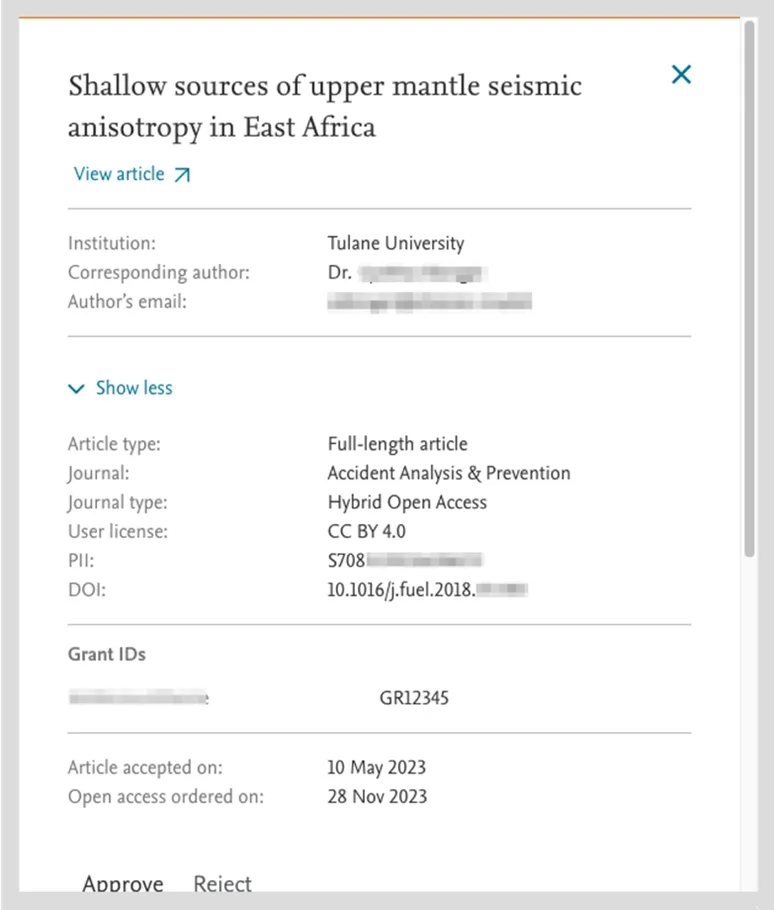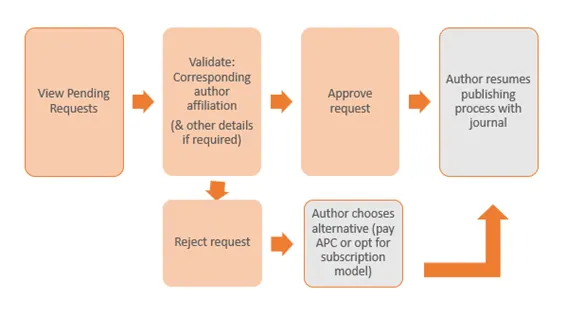Librarians share their top tips for managing institutional open access workflows
April 15, 2024
By Susan Jenkins

Streamlined processes enable libraries to support open science at their institutions and build relationships with their research communities.
As open science advances, read and publish agreements between publishers and institutions are encouraging more researchers to publish open access. The libraries managing these agreements are naturally keen to maximize their benefits for both authors and their institutions. To do this, libraries need to integrate workflows that can support their authors in choosing the open access (OA) route for their research and keep track of how an agreement is performing for their institution.
With efficient workflows, authors can benefit from OA publishing options. Libraries can also further leverage their insights from these agreements to build dialogue with their institutions around research publishing.
In a recent webinar, Elsevier spoke with Tulane University’s Andy Corrigan, Associate Dean of Libraries, and Kristin Sederstrom, Electronic Resources Librarian at the University of Kansas Medical Center, about the process of integrating workflows for new read and publish agreements at their institutions. In this article, we give an overview of a typical workflow and highlight some key takeaways that can help libraries implement similar workflows
4 components of a good open access workflow:
Offers a clear, consistent process for authors to request coverage of article publishing charges (APCs)
Supports libraries in efficiently validating and processing author requests based on criteria in their agreements
Provides a reporting function, so librarians can track and evaluate the impact of the agreement
Involve the right individuals in each step at the right time
Key terms for understanding open access workflows
Term | Definition |
Corresponding Author | Corresponding author is the author who submits the article to Elsevier and stays in contact with Elsevier for the end-to-end journey This is the author who makes the choice to publish open access or not on behalf of the author group Every article has one corresponding author |
Acceptance Date | The date the journal accepts the article for publication |
Article Publishing Charge (APC) | At Elsevier, these fees cover the costs of reviewing, editing, publishing and maintaining quality research in an open access journal. These can be paid by authors using a variety of funding sources, unless covered by agreements between publishers and institutions, consortia, or funding bodies. |
Elsevier OA Platform (EOAP) | The EOAP is a user-friendly interface where institutional administrators can view articles eligible for publishing under the OA agreement. Administrators at the institution validate the eligibility of the article under the agreement. |
Gold Open Access | Publishing model where the final version of the published journal article is made immediately, freely, and permanently available to read for everyone. An author can publish gold open access in a full open access journal or in a hybrid open access journal which offers either open access or subscription. |
Workflows in action
An open access workflow begins with an eligible author submitting an article to an eligible journal. Criteria outlined in the read and publish agreement govern the eligibility of an article for coverage. A digital workflow such as Elsevier’s Open Access Platform (or EOAP) automates this process for authors and libraries.

Author’s landing page after article has been accepted
Submitting requests- the author’s journey
When an author’s article is accepted for publication in one of Elsevier’s journals, an article acceptance letter is sent via email and includes a link to complete the publishing process. This launches a process on the EOAP where the author confirms affiliation, co-authors, and funding sources before requesting to be covered under the provisions of the agreement. Elsevier’s open access implementation team can help with configurations that make sense for your institution. Once submitted, the library’s administrator receives an email notification that a request is available in their EOAP dashboard. They can review the details and approve it, if eligible under the institution’s agreement.
The graphic below summarizes the workflow steps that authors complete before the library receives their request to cover publication under their institution’s agreement. In the process, the author also sees the amount of the article publishing charge (APC) that will be covered if the library validates it as eligible.

Author workflow
Approving requests – the library workflow
Once the author submits their request, the library begins its approval process. The EOAP has an institutional view where designated librarians can review and validate requests from authors and access reporting functions and agreement details.
During the webinar, Kristin pointed out the importance of being prepared in advance when implementing new open access workflows. At the University of Kansas, “our dashboard went live on January 6, and we immediately received a request for funding. Elsevier had posted information about our agreement to their website, so we had something to point our authors to for more details.”
She noted, “the implementation of the dashboard itself was very, very easy. We took part in a training demo to familiarize ourselves with the dashboard, how to use it, and what our authors will see.”
In the EOAP Requests area, librarians see a list of articles submitted for APC coverage approval, as well as those previously approved or declined. When an author submits a request, it appears there for the librarian to validate and approve.

EOAP Institutional view showing requests pending approval
Each APC coverage request links to a page displaying the article details as recorded by the author. Agreement administrators, typically librarians, need to confirm the corresponding author’s affiliation with their institution. Other criteria, such as article type, may also need to be validated against the agreement’s provisions.

Detail of EOAP approval page, institutional view
Both Kristin and Andy explained how this works at their respective institutions. Andy remarked that at Tulane, “We wanted it to be as seamless as possible for authors, so our only real interest is in confirming the eligibility of the author - are they indeed a Tulane affiliate?” Librarians will usually confirm authors through checking their email address.
The University of Kansas has a more complex situation. Among other aspects, Kristin explained that “even though we're a single university, we have our main campus in Lawrence and our medical campus in Kansas City, and each campus has different systems for verifying our authors' affiliation.” To enable that, “Elsevier was able to set up separate logins for each campus so we can [each] approve our own authors. Both of us having access has been essential to our workflow.”

Library workflow
A summary of the typical library workflow appears in the graphic above. Once a librarian approves a request, the author receives an email notifying them that the agreement applies.
If for some reason a request is not approved, the author has the option to pay the APC by other means, or to publish the article through the journal’s subscription-based model, if available.
Evaluating the value of an agreement – the reports workflow
Alongside the approval workflow, librarians and research leaders need to have a clear view on how their agreements are performing. In the EOAP’s Reports view, select librarian administrators can see the number of articles published under either the open access model or the subscription model through the agreement.

Reports view in the institutional dashboard of the EOAP
In the reports view, filters bring specific categories, time periods, and journals into focus, and monthly graphs provide a quick picture as well. Reports can be exported and integrated into a library’s overall reporting and tracking system. This gives librarians the ability to easily compare data over time and measure the value of the investment for their institution.
Getting the word out to the research community
An efficient open access workflow is great, but what if no one knows about it? Communicating with potential authors about a new agreement is just as important for successful uptake as the workflow itself.
As Andy describes it, “There has been a lot of discussion on our campuses here about the research life cycle and grant-funded research, and so [our agreement] really ties into that.” Agreements can provide support for the library to get involved in conversations with faculty and students about the research process.
Andy also noted that the process of negotiating the agreement and communicating about it “actually gave the library much more presence in the discussions about publishing” already happening on campus. This increased presence provides the libraries with an opportunity to further embed themselves on campus and collaborate with other departments involved in the research life cycle, demonstrating their necessity.
At the University of Kansas, Kristin and her colleagues worked with the libraries office of communications to draft campus-wide announcements. “We promoted the agreement via our daily news alerts, posted them on our respective websites and our open access initiatives pages.” The research administration office on the medical campus also shared information in their newsletter, and it was highlighted in each campus’s annual reports.
The communications strategy was similar at Tulane. Andy also noted that, because of the awareness raised by the publishing discussions, they lost no time when the agreement was activated, despite the time of year: “Since publishers usually operate on a calendar year cycle, we typically enter these agreements right before the holiday break, when everybody goes away. So, we worried about whether we would be able to promote this quickly enough. But surprisingly, we already had faculty who were asking about it before the agreements were finalized.”
7 Tips for implementing open access workflows
Consider what works best for your institution and agreements – one or multiple approvers, how to confirm affiliation, and what indicators will best measure return on investment
Take advantage of training or demos to learn how OA platforms work for both researchers and administrators
Designate people as approvers who have the best insight to validate author requests
Keep the validation process as simple as possible to ease implementation
Communicate early and widely with your research community about agreement benefits and workflow changes
Periodically invite the most active authors to information sessions about the OA publishing process
Regularly track and evaluate uptake of your agreements to see if authors are maximizing the opportunity to publish OA.
See the full conversation, Open Access Platforms: Empowering Transparent and Efficient Publishing Workflows at Choice360.org.
About the librarians:
Kristin Sederstrom
Electronic Resources Librarian University of Kansas Medical Center
Kristin Sederstrom is the Electronic Resources Librarian at the University of Kansas Medical Center, where she manages all aspects of the electronic resource life cycle, including open access workflows, and collaborates with colleagues at the Main campus to negotiate joint journal packages and OA agreements. Kristin holds an MLS from Emporia State University and has worked at KU in various library roles for 15 years.

Andy Corrigan
Associate Dean of Libraries Tulane University Libraries
Andy Corrigan has been Associate Dean of Libraries at Tulane since 2005, having first joined the university in the summer of 1994. He is also the library’s Chief Collections Officer and directs its collections planning and expenditures. He directed the library’s recovery initiatives after Hurricane Katrina, which included the salvage and replacement of lost or damaged collections. As part of the eventual remediation of the library’s flooded spaces, he was the library’s project manager during the FEMA-assisted construction of a 5th and 6th-floor addition atop Tulane’s main library building. He holds an EdD in Educational Administration from West Virginia University and an MLIS in Library and Information Science from the University of Rhode Island.

Interested in transformative agreements? Read interviews with Tulane’s Andy Corrigan and representatives from other institutions in the case study “Preparing for a transformative agreement: Library leaders share their experience”).
Contributor
